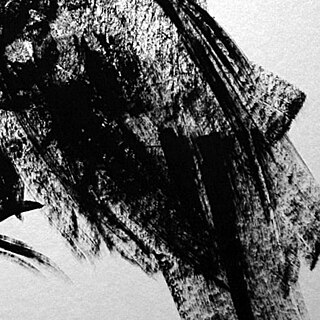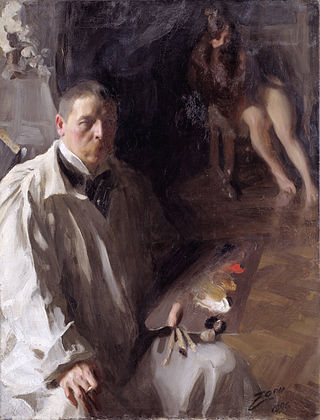
Acrylic paint is a fast-drying paint made of pigment suspended in acrylic polymer emulsion and plasticizers, silicone oils, defoamers, stabilizers, or metal soaps. Most acrylic paints are water-based, but become water-resistant when dry. Depending on how much the paint is diluted with water, or modified with acrylic gels, mediums, or pastes, the finished acrylic painting can resemble a watercolor, a gouache, or an oil painting, or have its own unique characteristics not attainable with other media and are meant for canvases.

Paint is a liquid pigment that, after applied to a solid material and allowed to dry, adds a film-like layer, in most cases to create an image, known as a painting. Paint can be made in many colors and types. Most paints are either oil-based or water-based, and each has distinct characteristics.

A pastel is an art medium that consist of powdered pigment and a binder. It can exist in a variety of forms, including a stick, a square, a pebble, or a pan of color, though other forms are possible. The pigments used in pastels are similar to those used to produce some other colored visual arts media, such as oil paints; the binder is of a neutral hue and low saturation. The color effect of pastels is closer to the natural dry pigments than that of any other process.

Gouache, body color, or opaque watercolor is a water-medium paint consisting of natural pigment, water, a binding agent, and sometimes additional inert material. Gouache is designed to be opaque. Gouache has a long history, having been used for at least twelve centuries. It is used most consistently by commercial artists for posters, illustrations, comics, and other design work.

Watercolor or watercolour, also aquarelle, is a painting method in which the paints are made of pigments suspended in a water-based solution. Watercolor refers to both the medium and the resulting artwork. Aquarelles painted with water-soluble colored ink instead of modern water colors are called aquarellum atramento by experts. However, this term has now tended to pass out of use.

Oil paint is a type of slow-drying paint that consists of particles of pigment suspended in a drying oil, commonly linseed oil. The viscosity of the paint may be modified by the addition of a solvent such as turpentine or white spirit, and varnish may be added to increase the glossiness of the dried oil paint film. The addition of oil or alkyd medium can also be used to modify the viscosity and drying time of oil paint. Oil paints were first used in Asia as early as the 7th century AD and can be seen in examples of Buddhist paintings in Afghanistan. Oil-based paints made their way to Europe by the 12th century and were used for simple decoration, but oil painting did not begin to be adopted as an artistic medium there until the early 15th century. Common modern applications of oil paint are in finishing and protection of wood in buildings and exposed metal structures such as ships and bridges. Its hard-wearing properties and luminous colors make it desirable for both interior and exterior use on wood and metal. Due to its slow-drying properties, it has recently been used in paint-on-glass animation. The thickness of the coat has considerable bearing on the time required for drying: thin coats of oil paint dry relatively quickly.

Velké Losiny is a spa municipality and village in Šumperk District in the Olomouc Region of the Czech Republic. It has about 2,500 inhabitants.

Drybrush is a painting technique in which a paint brush that is relatively dry, but still holds paint, is used to create a drawing or painting. Load is applied to a dry support such as paper or primed canvas. The resulting brush strokes have a characteristic scratchy and textured look that lacks the smooth appearance that washes or blended paint commonly have. This technique can be used to achieve a blurred or soft appearance.

A wash is a term for a visual arts technique resulting in a semi-transparent layer of colour. A wash of diluted ink or watercolor paint applied in combination with drawing is called pen and wash, wash drawing, or ink and wash. Normally only one or two colours of wash are used; if more colours are used the result is likely to be classified as a full watercolor painting.
Canson is a French manufacturer of fine art paper and related products. The company, established in 1557 by the Montgolfier family, produces papers for different uses in fine art, including watercolor, oil, acrylic, photo papers, among others.
Acrylic painting techniques are different styles of manipulating and working with polymer-based acrylic paints. Acrylics differ from oil paints in that they have shorter drying times and are soluble in water. These types of paint eliminate the need for turpentine and gesso, and can be applied directly onto canvas. Aside from painting with concentrated color paints, acrylics can also be watered down to a consistency that can be poured or used for glazes.

Painting is a visual art, which is characterized by the practice of applying paint, pigment, color or other medium to a solid surface. The medium is commonly applied to the base with a brush, but other implements, such as knives, sponges, and airbrushes, can be used.

John William North was a British landscape painter and illustrator, a prominent member of the Idyllists.

A palette is a surface on which a painter arranges and mixes paints. A palette is made of materials such as wood, paper, glass, ceramic or plastic, and can vary greatly in size and shape. Watercolor palettes are generally made of plastic or porcelain in a rectangular or wheel format, and have built in wells and mixing areas for colors. For acrylic painting, "stay wet" palettes exist, which prevent the paints from drying out and becoming inert.
Hahnemühle FineArt, Inc. is a paper manufacturing company in the Relliehausen district of Dassel, Germany. It is a significant producer of coated paper for inkjet printing, artist's paper for traditional painting and printing techniques, and filter paper for industry and research.

Royal Talens is a Dutch company located in Apeldoorn that specializes in art materials. The company produces and markets its own products, apart from commercializing other licensed brands, such as Van Gogh, Rembrandt, and Bruynzeel. Products commercialised include acrylic paints, oil paints, watercolor paintings, brushes, markers, inks, pastels, pencils, pens, gouache, canvas, papers.

The conservation and restoration of paintings is carried out by professional painting conservators. Paintings cover a wide range of various mediums, materials, and their supports. Painting types include fine art to decorative and functional objects spanning from acrylics, frescoes, and oil paint on various surfaces, egg tempera on panels and canvas, lacquer painting, water color and more. Knowing the materials of any given painting and its support allows for the proper restoration and conservation practices. All components of a painting will react to its environment differently, and impact the artwork as a whole. These material components along with collections care will determine the longevity of a painting. The first steps to conservation and restoration is preventive conservation followed by active restoration with the artist's intent in mind.

Paint mixing is the practice of mixing components or colors of paint to combine them into a working material and achieve a desired hue. The components that go into paint mixing depend on the function of the product sought to be produced. For example, a painter of portraits or scenery on a canvas may be seeking delicate hues and subtle gradiations, while the painter of a house may be more concerned with durability and consistency of colors in paints presented to customers, and the painter of a bridge or a ship may have the weatherability of the paint as their primary concern.
Van Dyke (Vandyke) brown, also known as Cassel earth or Cologne earth, is a deep, rich, and warm brown colour often used in painting and printmaking. Early publications on the pigment refer to it as Cassel earth or Cologne earth in reference to its city of origin; however, today it is typically called Van Dyke brown after the painter Anthony van Dyck.

The Paper mill at Velké Losiny is a historic mill in Velké Losiny in the Olomouc Region of the Czech Republic. It was founded in the late 16th century and is manufacturing handmade paper to this day. The four-hundred-year continuity of traditional handmade paper production is unparalleled in Central Europe and in 2001 the paper mill was declared a Czech national cultural monument.

















